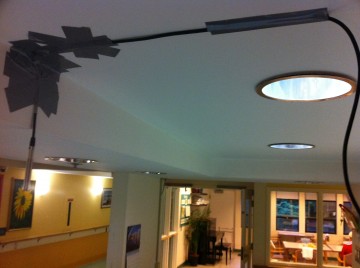
- Noise is potentially hazardous not only to hearing, but also to normal physiological and psychological functioning.
- The complex hospital soundscape contributes to healthcare worker stress and burnout, known risk factors for job dissatisfaction and absenteeism.
- Research suggests that high levels of noise leads to increased levels of aggression against staff
- Approximately 40% of all violence-related workers’ compensation claims occur among health care workers, although these workers make up less than 10% of the workforce in British Columbia
- The results of a B.C. based pilot study suggested that long term care (residential) facilities had the poorest acoustical conditions of the three types of facilities examined (acute, residential/long term and community), including the highest average personal exposures and staff perceptions of noise levels.
Objectives:

Area noise level measurement using a sound level meter with a microphone hanging from the ceiling
Primary Objective:
To evaluate the association between the acoustic characteristics of a long term care facility and patient aggression and overall stress in front-line healthcare workers (care aides, LPNs, RNs). Furthermore to assess evidence of a possible dose-response when examining the acoustic environment among different LTC facilities in the lower mainland of British Columbia.
Secondary Objectives:
- To determine which acoustical parameters (noise levels, speech intelligibility, reverberation time) predict patients’ aggressive behaviour
- To determine if perceived noise is a good predictor of stress and whether perceived noise interacts with measured noise
- To determine if perceived stress correlates with experienced stress (physiologic changes)
Methods

Acoustics measurement device placed in a nursing station
- Measurements of acoustical environments including noise levels in key areas such as nursing stations
- Assessments of stress and experience of patient aggression were measured by examining Cortisol (a hormone which can indicate chronic stress if elevated) in saliva samples taken by participants
- Measurements of Heart rate variability (an indicator of chronic stress on the cardiovascular system), through monitors worn by participants
- Assessing self-reported exposures to noise and self-reported indicators of stress through a standardized questionnaire including a daily diary to determine perceived stress and event-based stress
